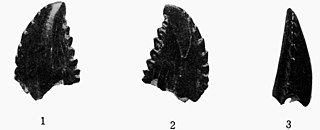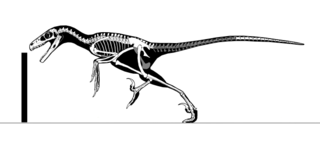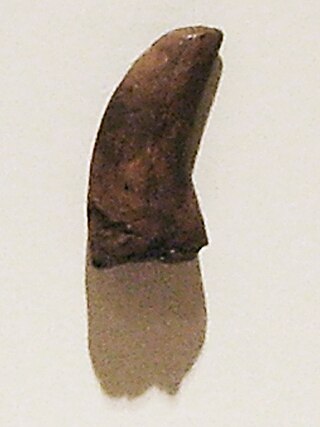
Troodon is a former wastebasket taxon and a highly likely dubious genus of relatively small, bird-like theropod dinosaurs definitively known from the Campanian age of the Late Cretaceous period. It includes at least one species, Troodon formosus, known from Montana. Discovered in October 1855, T. formosus was among the first dinosaurs found in North America, although it was thought to be a lizard until 1877. Several well-known troodontid specimens from the Dinosaur Park Formation in Alberta were once believed to be members of this genus. However, recent analyses in 2017 have found this genus to be undiagnostic and referred some of these specimens to the genus Stenonychosaurus some to the genus Latenivenatrix, and some to the genus Pectinodon. The genus name is Ancient Greek for "wounding tooth", referring to the teeth, which were different from those of most other theropods known at the time of their discovery. The teeth bear prominent, apically oriented serrations. These "wounding" serrations, however, are morphometrically more similar to those of herbivorous reptiles, and suggest a possibly omnivorous diet.

Dromaeosaurus is a genus of dromaeosaurid theropod dinosaur which lived during the Late Cretaceous period, sometime between 80 and 69 million years ago, in Alberta, Canada and the western United States. The type species is Dromaeosaurus albertensis, which was described by William Diller Matthew and Barnum Brown in 1922. Its fossils were unearthed in the Dinosaur Park Formation. Teeth attributed to this genus have been found in the Prince Creek Formation. Dromaeosaurus is the type genus of both Dromaeosauridae and Dromaeosaurinae, which include many genera with similar characteristics to Dromaeosaurus such as possibly its closest relative Dakotaraptor. Dromaeosaurus was heavily built, more so than other dromaeosaurs that are similar in size, like Velociraptor.

Saurornitholestes is a genus of carnivorous dromaeosaurid theropod dinosaur from the late Cretaceous of Canada (Alberta) and the United States.

Saurornithoides is a genus of troodontid maniraptoran dinosaur, which lived during the Late Cretaceous period. These creatures were predators, which could run fast on their hind legs and had excellent sight and hearing. The name is derived from the Greek stems saur~ (lizard), ornith~ (bird) and eides (form), referring to its bird-like skull.

Xinjiangovenator is a genus of coelurosaurian dinosaurs, possibly part of the group Maniraptora, which lived during the Early Cretaceous period, sometime between the Valanginian and Albian stages. The remains of Xinjiangovenator were found in the Lianmuqin Formation of Wuerho, Xinjiang, China, and were first described by Dong Zhiming in 1973. The genus is based on a single specimen, an articulated partial right lower leg, containing the tibia, three pieces of the fibula, the calcaneum and the astragalus. This specimen, IVPP V4024-2, is the holotype of the genus.

Zapsalis is a genus of dromaeosaurine theropod dinosaurs. It is a tooth taxon, often considered dubious because of the fragmentary nature of the fossils, which include teeth but no other remains.

Paronychodon was a theropod dinosaur genus. It is a tooth taxon, often considered dubious because of the fragmentary nature of the fossils, which include "buckets" of teeth from many disparate times and places but no other remains, and should be considered a form taxon.
Asiamericana (AY-zha-MER-i-KAHN-a – is a dubious genus of coelurosaur known only from isolated teeth found in the Bissekty Formation of Kazakhstan. It was named to recognize the occurrence of similar fossil teeth in Central Asia and North America. These regions once formed a connected land mass, during the Cretaceous period and were referred to as Asiamerica.

Pectinodon is a genus of troodontid theropod dinosaurs from the end of the Maastrichtian age of the Late Cretaceous period (66 mya). It currently contains a single valid species, Pectinodon bakkeri, known only from teeth.
Taveirosaurus (tah-VAY-roo-SAWR-us) is a genus of ornithischian dinosaur that lived in Europe during the Late Cretaceous. The genus is based solely on teeth.

Sinovenator is a genus of troodontid dinosaur from China. It is from the early Cretaceous Period.

Dromaeosauroides is a genus of dromaeosaurid theropod dinosaur from the Early Cretaceous of what is now Denmark and possibly also England. It was discovered in the Jydegaard Formation in the Robbedale valley, on the island of Bornholm in the Baltic Sea. This is the only likely place for dinosaur remains to be discovered on Danish territory, since the Mesozoic deposits exposed in the rest of the country are marine. Dromaeosauroides is the first known dinosaur from this location, and the only one which has been scientifically named. It is one of the oldest known dromaeosaurs in the world, and the first known uncontested dromaeosaur from the Early Cretaceous of Europe.

Graciliraptor is a genus of theropod dinosaur from the early Cretaceous Period. It is a microraptorine dromaeosaurid.

Suchosaurus is a spinosaurid dinosaur from Cretaceous England and Portugal, originally believed to be a genus of crocodile. The type material, consisting of teeth, was used by British palaeontologist Richard Owen to name the species S. cultridens in 1841. Later in 1897, French palaeontologist Henri-Émile Sauvage named a second species, S. girardi, based on two fragments from the mandible and one tooth discovered in Portugal. Suchosaurus is possibly a senior synonym of the contemporary spinosaurid Baryonyx, but is usually considered a dubious name due to the paucity of its remains, and is considered an indeterminate baryonychine. In the Wadhurst Clay Formation of what is now southern England, Suchosaurus lived alongside other dinosaurs, as well as plesiosaurs, mammals, and crocodyliforms.
Urbacodon is a genus of troodontid dinosaur, a type of small carnivore. It lived in Uzbekistan during the early Late Cretaceous Period, about 95 million years ago.

Austroraptor is a genus of dromaeosaurid theropod dinosaur that lived during the Maastrichtian age of the Late Cretaceous period in what is now Argentina.

Xixiasaurus is a genus of troodontid dinosaur that lived during the Late Cretaceous Period in what is now China. The only known specimen was discovered in Xixia County, Henan Province, in central China, and became the holotype of the new genus and species Xixiasaurus henanensis in 2010. The names refer to the areas of discovery, and can be translated as "Henan Xixia lizard". The specimen consists of an almost complete skull, part of the lower jaw, and teeth, as well as a partial right forelimb.

Acheroraptor is an extinct genus of dromaeosaurid theropod dinosaur known from the latest Maastrichtian Hell Creek Formation of Montana, United States. It contains a single species, Acheroraptor temertyorum. A. temertyorum is one of the two geologically youngest known species of dromaeosaurids, the other being Dakotaraptor, which is also known from Hell Creek. A basal cousin of Velociraptor, Acheroraptor is known from upper and lower jaw material.

This timeline of troodontid research is a chronological listing of events in the history of paleontology focused on the troodontids, a group of bird-like theropod dinosaurs including animals like Troodon. Troodontid remains were among the first dinosaur fossils to be reported from North America after paleontologists began performing research on the continent, specifically the genus Troodon itself. Since the type specimen of this genus was only a tooth and Troodon teeth are unusually similar to those of the unrelated thick-headed pachycephalosaurs, Troodon and its relatives would be embroiled in taxonomic confusion for over a century. Troodon was finally recognized as distinct from the pachycephalosaurs by Phil Currie in 1987. By that time many other species now recognized as troodontid had been discovered but had been classified in the family Saurornithoididae. Since these families were the same but the Troodontidae named first, it carries scientific legitimacy.

Oksoko is a genus of oviraptorid dinosaur from the Late Cretaceous of Asia, that lived in what is now the Nemegt Formation in Mongolia. It includes the type species Oksoko avarsan.

















